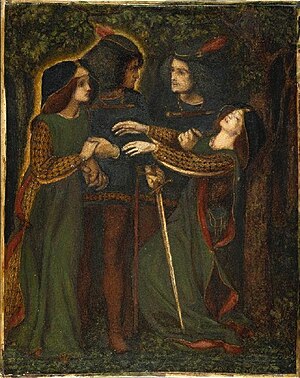Doppelgänger: Difference between revisions
m |
Goblin Face (talk | contribs) No edit summary |
||
| Line 33: | Line 33: | ||
|pages=21–22 |
|pages=21–22 |
||
|title=Haunted England: A survey of English ghost-lore}}</ref> |
|title=Haunted England: A survey of English ghost-lore}}</ref> |
||
==Psychology== |
|||
[[Heautoscopy]] is a [[glossary of psychiatry|term used in psychiatry]] and neurology for the reduplicative [[hallucination]] of "seeing one's own body at a distance".<ref>{{cite journal | author=Damas Mora JMR, Jenner FA, Eacott SE | title=On heautoscopy or the phenomenon of the double: Case presentation and review of the literature| journal=Br J Med Psychol | year=1980 | volume=53 | pages= 75–83 | pmid=6989391 | issue=1}}</ref> It can occur as a symptom in [[schizophrenia]]<ref>{{cite journal |url=http://www.susanblackmore.co.uk/Articles/JNMD86.htm | author=Blackmore S | title=Out-of-Body Experiences in Schizophrenia: A Questionnaire Survey| journal =Journal of Nervous and Mental Disease|year=1986|volume=174|pages=615–619 | doi=10.1097/00005053-198610000-00006 |pmid=3760852 |issue=10}}</ref> and [[epilepsy]]. Heautoscopy is considered a possible explanation for doppelgänger phenomena.<ref>Brugger, P; Agosti, R; Regard, M; Wieser, H. G; Landis, T. (1994). ''Heautoscopy, epilepsy, and suicide''. Journal of Neurology, Neurosurgergy and Psychiatry 57: 838-839.</ref> |
|||
==See also== |
==See also== |
||
Revision as of 18:23, 4 May 2014

In fiction and folklore, a doppelgänger or doppelganger (/ˈdɒpəlˌɡæŋər/; German: [ˈdɔpəlˌɡɛŋɐ] , look-alike, literally a "double goer") is a double of a living person and sometimes portrayed as a harbinger of bad luck. In some traditions, a doppelgänger seen by a person's relative or friend portends illness or danger while seeing one's own doppelgänger is said to be an omen of death.
In contemporary vernacular, the word doppelgänger is often used in a more general sense to identify any person that physically or perhaps even behaviorally resembles another person.
Spelling
The word doppelgänger is a loanword from German Doppelgänger, consisting of the two substantives Doppel (double) Gänger (walker or goer).[1][2] The singular and plural form are the same in German, but English usually prefers the plural "doppelgangers." It was first used by Jean Paul in the novel Siebenkäs (1796), and his newly coined word is explained by a footnote.
As is true for all other common nouns in German, the word is written with an initial capital letter. In English, the word is conventionally uncapitalized (doppelgänger). It is also common to drop the diacritic diaeresis, writing "doppelganger."
Mythology
Although this German word is of relatively recent origin, first appearing in English use in 1851,[3] the concept of alter egos and double spirits appears in the folklore, myths, religious concepts, and traditions of many cultures throughout human history.
In Ancient Egyptian mythology, a ka was a tangible "spirit double" having the same memories and feelings as the person to whom the counterpart belongs. In one Egyptian myth entitled, The Greek Princess, an Egyptian view of the Trojan War, a ka of Helen was used to mislead Paris of Troy, helping to stop the war.
In Norse mythology, a vardøger is a ghostly double who precedes a living person and is seen performing their actions in advance. In Finnish mythology, this is called having an etiäinen, i.e., "a firstcomer".
In some[which?] myths, the doppelgänger is a version of the Ankou, a Breton personification of death.
Literature
In Prometheus Unbound by Percy Bysshe Shelley, the concept of a doppelganger double was described as a counterpart to the self. The work of Edgar Allan Poe describes the double with sinister, demonic qualities. George Gordon Byron used doppelganger imagery to explore the duality of human nature.[4] Charles Williams Descent Into Hell (1939), has character Pauline Anstruther seeing her own doppelganger all through her life.[5]
Folkore
Contemporary English folklore contains the story of Vice-Admiral Sir George Tryon who was supposedly seen walking through the drawing room of his family home in Eaton Square, London at the same time he had gone down with his ship, HMS Victoria after colliding with HMS Camperdown.[6]
Psychology
Heautoscopy is a term used in psychiatry and neurology for the reduplicative hallucination of "seeing one's own body at a distance".[7] It can occur as a symptom in schizophrenia[8] and epilepsy. Heautoscopy is considered a possible explanation for doppelgänger phenomena.[9]
See also
References
- ^ New Oxford American Dictionary, 2nd Edition, 2005.
- ^ Doppelgänger; Orthography, Meaning Synonyms www.duden.de
- ^ date of first use in English according to Merriam Webster dictionary
- ^ Frederick Burwick (8 November 2011). Playing to the Crowd: London Popular Theatre, 1780-1830. Palgrave Macmillan. pp. 83–. ISBN 978-0-230-37065-4.
- ^ Charles Williams (1939). Descent Into Hell.
- ^ Christina Hole (1950). Haunted England: A survey of English ghost-lore. B. T. Batsford. pp. 21–22.
- ^ Damas Mora JMR, Jenner FA, Eacott SE (1980). "On heautoscopy or the phenomenon of the double: Case presentation and review of the literature". Br J Med Psychol. 53 (1): 75–83. PMID 6989391.
{{cite journal}}: CS1 maint: multiple names: authors list (link) - ^ Blackmore S (1986). "Out-of-Body Experiences in Schizophrenia: A Questionnaire Survey". Journal of Nervous and Mental Disease. 174 (10): 615–619. doi:10.1097/00005053-198610000-00006. PMID 3760852.
- ^ Brugger, P; Agosti, R; Regard, M; Wieser, H. G; Landis, T. (1994). Heautoscopy, epilepsy, and suicide. Journal of Neurology, Neurosurgergy and Psychiatry 57: 838-839.
Further reading
- Otto Rank. The Double: A Psychoanalytic Study. 1925 (written 1914).
- Rodney Davies. (2001). Doubles: The Enigma of the Second Self. Robert Hale Ltd. ISBN 978-0709061182
